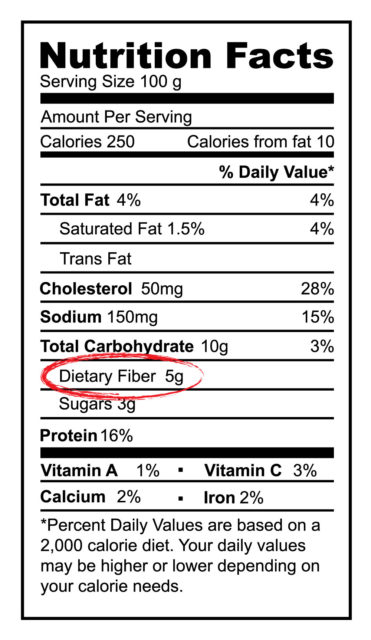Fiber
Maybe you’ve heard about the benefits of fiber in the diet, but you’re not sure if you’re getting enough fiber. What are the benefits? And what foods contain fiber? Whole grains are an excellent source of fiber!
What is Fiber?
Fiber is a complex carbohydrate. There are two types, dietary and functional. Dietary fiber is the naturally occurring non-digestible parts of plants (leaves, stems, and seeds); whereas, functional fiber is added to food and is the form used in supplements. Functional fiber can be seen as cellulose, guar gum, pectin and psyllium in the ingredient list on the nutrition facts label. The total seen on the nutrition facts level is the sum of both the dietary and functional fiber found in the product. Our body does not easily break down fiber; therefore, it passes through the gastrointestinal track without being digested or absorbed.
This complex carbohydrate offers many health benefits. You may be thinking, what kind of nutritional benefits can fiber have in our diets if it isn’t digested or absorbed by our bodies? According to USDA’s My Plate, dietary fiber may help reduce blood cholesterol levels and lower the risk of heart disease, obesity and type 2 diabetes. It’s also important for proper bowel function, helping to reduce constipation and diverticulosis. It also helps with weight management and can provide a feeling of fullness with fewer calories.
Fiber is either classified as soluble or insoluble depending on its chemical and physical properties. Each type has different health benefits so it’s important to eat a variety of foods.
- Soluble Fiber is found in citrus fruits, berries, oat products and beans and can reduce the risk of cardiovascular disease and type 2 diabetes by lowering cholesterol and blood glucose levels.
- Insoluble Fiber is found in whole grains, such as wheat, rye, and brown rice as well as in many vegetables and is known for promoting regular bowel movements and reducing the risk for diverticulitis.
Sources of Dietary Fiber
Whole grains, vegetables, fruits, nuts and seeds are good sources of fiber. Whole grains are made up of the bran, endosperm and germ of a grain kernel. The bran (the outermost covering) is very high in fiber. Even when processed the bran, endosperm and germ remain in the final product of a whole grain like whole wheat flour. Whereas, refined and enriched grains only retain about 25% of the wheat’s fiber, vitamins and minerals as the bran and germ have been removed during processing so that only the endosperm remains. Grains have varying amounts of DF so it’s important to look at the nutrition facts label to determine the amount per serving that a particular product contains.
Supplements are common in the marketplace and while they do provide some fiber, it is best to consume it from the foods you eat as those foods provide vitamins, minerals and phytochemicals, also!
Choosing Fiber Rich Foods
The nutrition facts label can be helpful in determining how much fiber is in a product. In order for a product to be considered a “Good” source it must contain at least 3 grams per serving. To be an “Excellent” source it must contain 5 or more grams per serving. For foods like fresh fruits and vegetables without a label, this almost guarantees they are fiber rich! Be sure to consume the skin or peel as that is primarily where the it lies.
How Much Do We Need?
It is recommended that women consume at least 25 grams of fiber per day while men should consume 38 grams per day. The majority of Americans do not consume enough, with the average consumption being 15 grams for females and 18 grams for males. Beware, you can consume too much! Excessive fiber consumption can lead to intestinal gas, bloating and constipation. Most Americans have difficulty tolerating more than 50 grams per day. If you haven’t been consuming enough and are planning to increase your fiber intake, be sure to increase your water intake to prevent constipation. You should consume at least eight 8-ounce glasses of fluid each day!
Ways to Incorporate More into Your Day
- Choose whole grain bread or whole grain tortillas.
- Select high-fiber breakfast cereal with at least 5 grams per serving.
- Consume cut fruit or vegetables (with the peel on) for a quick mid-morning or afternoon snack.
- Incorporate one of these whole grain snacks into your day.
- Eat legumes (beans) every day! Add them on salads, tacos, in casseroles or soups, or other favorite dishes!
- Choose whole-wheat pasta instead of regular pasta. Try this garden pasta primavera recipe that contains whole-wheat linguine and a variety of fiber rich vegetables!

— Contributed by Jill Ladd, MPH, RD, LD
Want to learn more about where your food comes from? Check out the Knopfs, a farming family in south central Kansas! Whole grains are an important source of fiber, so check out some of these great tips from Jill to help your kiddos consume more whole grains. Or would you like to learn more about the power of wheat foods? Check out our great partner, the Wheat Foods Council!
